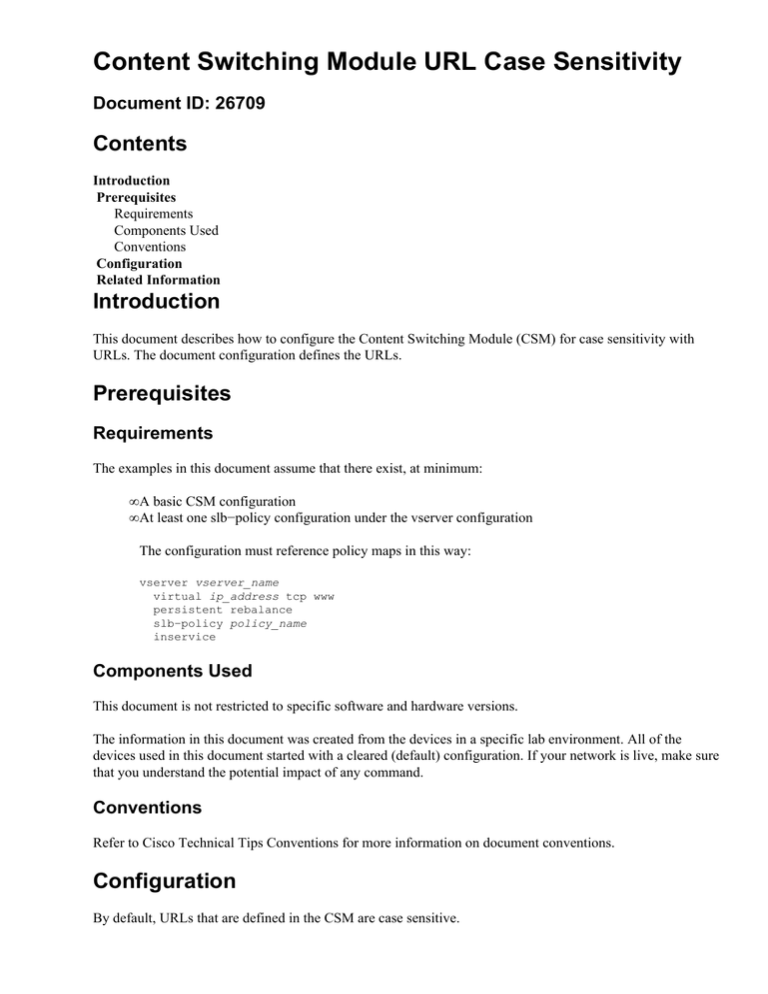
Content Switching Module URL Case Sensitivity
Document ID: 26709
Contents
Introduction
Prerequisites
Requirements
Components Used
Conventions
Configuration
Related Information
Introduction
This document describes how to configure the Content Switching Module (CSM) for case sensitivity with
URLs. The document configuration defines the URLs.
Prerequisites
Requirements
The examples in this document assume that there exist, at minimum:
• A basic CSM configuration
• At least one slb−policy configuration under the vserver configuration
The configuration must reference policy maps in this way:
vserver vserver_name
virtual ip_address tcp www
persistent rebalance
slb−policy policy_name
inservice
Components Used
This document is not restricted to specific software and hardware versions.
The information in this document was created from the devices in a specific lab environment. All of the
devices used in this document started with a cleared (default) configuration. If your network is live, make sure
that you understand the potential impact of any command.
Conventions
Refer to Cisco Technical Tips Conventions for more information on document conventions.
Configuration
By default, URLs that are defined in the CSM are case sensitive.
Consider this example, which defines a policy map. The example references both a user−defined url−map and
a serverfarm:
Note: The serverfarm has the name SFARM1 in this example.
map LOWERCASE_ONLY url
match protocol http url /test*
policy LOWERCASE_ONLY
url−map LOWERCASE_ONLY
serverfarm SFARM1
If you enter http://www.domain.com/Test.html, an error is returned. The error states that the document cannot
be found. The error occurs because you entered an uppercase T, rather than a lowercase t. The CSM sends a
reset (RST) immediately after the CSM receives the client GET request, which results in the error.
For case insensitivity, configure the CSM to allow any possible combination of uppercase and lowercase
characters. Here is an example:
Test
TeSt
TEST
Now, consider this policy map, which references another user−defined url−map with the name ANY_CASE.
This policy map uses regular expressions to allow for case insensitivity:
map ANY_CASE url
match protocol http url /[T|t][E|e][S|s][T|t]*
policy ANY_CASE
url−map ANY_CASE
serverfarm SFARM1
The latter of these two configurations defines the regular expression. The regular expression allows for any
combination of uppercase and lowercase characters for the word "test", which can be followed by any other
sequence of characters. The addition of the wildcard (*) denotes any other sequence of characters to follow.
Related Information
• Cisco Content Switching Module Hardware Support
• Software Download − Cisco Catalyst 6000 Content Switching Module ( registered customers only)
• Technical Support & Documentation − Cisco Systems
Contacts & Feedback | Help | Site Map
© 2013 − 2014 Cisco Systems, Inc. All rights reserved. Terms & Conditions | Privacy Statement | Cookie Policy | Trademarks of
Cisco Systems, Inc.
Updated: Dec 12, 2005
Document ID: 26709

